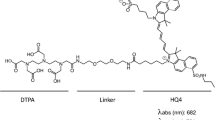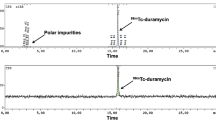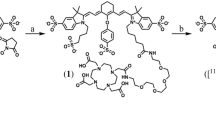Abstract
Purpose
Noninvasive imaging of treatment-induced necrosis is important to distinguish early responders from patients resistant to the treatment plan, enabling the tailored-made therapeutic intervention. The purpose of this study was to explore the feasibility of [99mTc]EDDA-HYNIC-2C-rhein for early assessment of tumor response to treatment.
Procedures
In vitro necrosis avidity of [99mTc]EDDA-HYNIC-2C-rhein was evaluated in human lung cancer A549 cells treated with hyperthermia. Single photon emission–computed tomography/X-ray-computed tomography (SPECT/CT) imaging was performed in rats bearing subcutaneous W256 tumor treated with combretastatin A-4 disodium phosphate (CA4P) and rats bearing orthotopic liver W256 tumor treated with a single microwave ablation. All rats were euthanized immediately after the imaging session for biodistribution and histology studies. The mechanism of necrosis avidity for the tracer was further explored by in vivo blocking experiment and in vitro histochemistry and fluorescence staining.
Results
The uptake of [99mTc]EDDA-HYNIC-2C-rhein in necrotic cells was significantly higher than that in viable cells (p < 0.05). SPECT/CT imaging showed that an obvious “hot spot” was observed in the CA4P-treated tumor while not in the control tumor at 5 h after tracer injection. Ex vivo γ-counting revealed that the uptake of [99mTc]EDDA-HYNIC-2C-rhein in tumor was increased 3.5-fold in rats treated with CA4P compared with rats treated with vehicle. Autoradiography and corresponding H&E staining suggested that the higher overall radiotracer uptake in the treated tumors was attributed to the increased necrosis. Blocking with unlabeled HYNIC-2C-rhein demonstrated the specific binding of the radiotracer to necrotic tissues. The perfect match of autoradiograph and histochemistry staining and PI fluorescence staining revealed that necrosis avidity of the tracer may be attributable to intercalation with exposed DNA in necrotic tissues.
Conclusion
[99mTc]EDDA-HYNIC-2C-rhein can image necrosis induced by anticancer therapy and holds potential for early assessment of treatment response.





Similar content being viewed by others
References
Elvas F, Vangestel C, Pak K, Vermeulen P, Gray B, Stroobants S, Staelens S, Wyffels L (2016) Early prediction of tumor response to treatment: preclinical validation of 99mTc-duramycin. J Nucl Med 57:805–811
Elvas F, Boddaert J, Vangestel C, Pak K, Gray B, Kumar-Singh S, Staelens S, Stroobants S, Wyffels L (2017) 99mTc-Duramycin SPECT imaging of early tumor response to targeted therapy: a comparison with 18F-FDG PET. J Nucl Med 58:665–670
Eisenhauer EA, Therasse P, Bogaerts J, Schwartz LH, Sargent D, Ford R, Dancey J, Arbuck S, Gwyther S, Mooney M, Rubinstein L, Shankar L, Dodd L, Kaplan R, Lacombe D, Verweij J (2009) New response evaluation criteria in solid tumours: revised RECIST guideline (version 1.1). Eur J Cancer 45:228–247
Wahl RL, Jacene H, Kasamon Y, Lodge MA (2009) From RECIST to PERCIST: evolving considerations for PET response criteria in solid tumors. J Nucl Med 50:122S–150S
Weissleder R (2006) Molecular imaging in cancer. Science 312:1168–1171
Chang JM, Lee HJ, Goo JM, Lee HY, Lee JJ, Chung JK, Im JG (2006) False positive and false negative FDG-PET scans in various thoracic diseases. Korean J Radiol 7:57–69
Ben-Haim S, Ell P (2009) 18F-FDG PET and PET/CT in the evaluation of cancer treatment response. J Nucl Med 50:88–99
Siemann DW (2011) The unique characteristics of tumor vasculature and preclinical evidence for its selective disruption by tumor-vascular disrupting agents. Cancer Treat Rev 37:63–74
Pérez-Pérez MJ, Priego EM, Bueno O, Martins MS, Canela MD, Liekens S (2016) Blocking blood flow to solid tumors by destabilizing tubulin: an approach to targeting tumor growth. J Med Chem 59:8685–8711
Siemann DW, Chaplin DJ, Walicke PA (2009) A review and update of the current status of the vasculature-disabling agent combretastatin-A4 phosphate (CA4P). Expert Opin Investig Drugs 18:189–197
Jaroch K, Karolak M, Górski P, Jaroch A, Krajewski A, Ilnicka A, Sloderbach A, Stefański T, Sobiak S (2016) Combretastatins: in vitro structure-activity relationship, mode of action and current clinical status. Pharmacol Rep 68:1266–1275
Pisetsky DS, Fairhurst AM (2007) The origin of extracellular DNA during the clearance of dead and dying cells. Autoimmunity 40:281–284
Vlassov VV, Laktionov PP, Rykova EY (2007) Extracellular nucleic acids. Bioessays 29:654–667
Luo Q, Jin Q, Su C et al (2016) Radiolabeled rhein as novel small-molecule necrosis avid agents for rapid imaging of necrotic myocardium. Anal Chem 89:1260–1266
Perek N, Sabido O, Le Jeune N et al (2008) Could 99mTc-glucarate be used to evaluate tumour necrosis? Eur J Nucl Med Mol Imaging 35:1290–1298
Brader P, Riedl CC, Woo Y, Ponomarev V, Zanzonico P, Wen B, Cai S, Hricak H, Fong Y, Blasberg R, Serganova I (2007) Imaging of hypoxia-driven gene expression in an orthotopic liver tumor model. Mol Cancer Ther 6:2900–2908
Olive PL, Banáth JP (2006) The comet assay: a method to measure DNA damage in individual cells. Nat Protoc 1:23–29
Thorpe PE (2004) Vascular targeting agents as cancer therapeutics. Clin Cancer Res 10:415–427
Ni Y, Chen F, Mulier S, Sun X, Yu J, Landuyt W, Marchal G, Verbruggen A (2006) Magnetic resonance imaging after radiofrequency ablation in a rodent model of liver tumor: tissue characterization using a novel necrosis-avid contrast agent. Eur Radiol 16:1031–1040
Dasari M, Lee S, Sy J, Kim D, Lee S, Brown M, Davis M, Murthy N (2010) Hoechst-IR: an imaging agent that detects necrotic tissue in vivo by binding extracellular DNA. Org Lett 12:3300–3303
Smith BA, Smith BD (2012) Biomarkers and molecular probes for cell death imaging and targeted therapeutics. Bioconjug Chem 23:1989–2006
Khan RS, Martinez MD, Sy JC et al (2014) Targeting extracellular DNA to deliver IGF-1 to the injured heart. Sci Rep 4:4257
Zhang D, Gao M, Yao N et al (2018) Preclinical evaluation of radioiodinated Hoechst 33258 for early prediction of tumor response to treatment of vascular-disrupting agents. Contrast Media Mol Imaging 2018:5237950
Huang S, Chen HH, Yuan H, Dai G, Schule D, Ngoy S, Liao R, Caravan P, Josephson L, Sosnovik D (2011) Molecular MRI of acute necrosis with a novel DNA-binding gadolinium chelate: kinetics of cell death and clearance in infarcted myocardium. J Cardiovasc Magn Reson 13:O23
Witney TH, Hoehne A, Reeves RE, Ilovich O, Namavari M, Shen B, Chin FT, Rao J, Gambhir SS (2015) A systematic comparison of 18F-C-SNAT to established radiotracer imaging agents for the detection of tumor response to treatment. Clin Cancer Res 21:3896–3905
Wang K, Purushotham S, Lee JY, Na MH, Park H, Oh SJ, Park RW, Park JY, Lee E, Cho BC, Song MN, Baek MC, Kwak W, Yoo J, Hoffman AS, Oh YK, Kim IS, Lee BH (2010) In vivo imaging of tumor apoptosis using histone H1-targeting peptide. J Control Release 148:283–291
Kwak W, Ha YS, Soni N, Lee W, Park SI, Ahn H, An GI, Kim IS, Lee BH, Yoo J (2015) Apoptosis imaging studies in various animal models using radio-iodinated peptide. Apoptosis 20:110–121
Kim S, Kim D, Lee Y, Jeon H, Lee BH, Jon S (2015) Conversion of low-affinity peptides to high-affinity peptide binders by using a β-hairpin scaffold-assisted approach. Chembiochem 16:43–46
Belhocine T, Steinmetz N, Hustinx R, Bartsch P, Jerusalem G, Seidel L, Rigo P, Green A (2002) Increased uptake of the apoptosis-imaging agent 99mTc recombinant human Annexin V in human tumors after one course of chemotherapy as a predictor of tumor response and patient prognosis. Clin Cancer Res 8:2766–2774
Kemerink GJ, Liu X, Kieffer D, Ceyssens S, Mortelmans L, Verbruggen AM, Steinmetz ND, Vanderheyden JL, Green AM, Verbeke K (2003) Safety, biodistribution, and dosimetry of 99mTc-HYNIC-annexin V, a novel human recombinant annexin V for human application. J Nucl Med 44:947–952
Blankenberg FG (2008) In vivo detection of apoptosis. J Nucl Med 49:81S–95S
Acknowledgments
We thank Mr. Changwen Fu for his kind work in SPECT/CT scanning.
Funding
This study was partially sponsored by the National Natural Science Foundation of China (No. 81473120, 81501536, 81771870).
Author information
Authors and Affiliations
Corresponding authors
Ethics declarations
Conflict of Interest
The authors declare that they have no conflicts of interest. Jiajia Liang and Qi Luo contributed equally to this paper.
Rights and permissions
About this article
Cite this article
Liang, J., Luo, Q., Zhang, D. et al. SPECT Imaging of Treatment-Related Tumor Necrosis Using Technetium-99m-Labeled Rhein. Mol Imaging Biol 21, 660–668 (2019). https://doi.org/10.1007/s11307-018-1285-9
Published:
Issue Date:
DOI: https://doi.org/10.1007/s11307-018-1285-9




